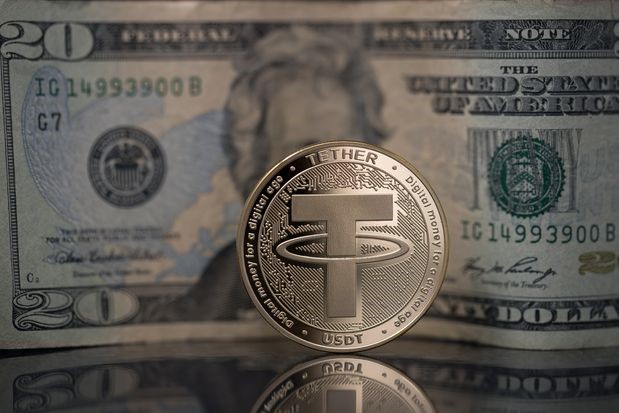Visa and PayPal Could Fall Behind Crypto Dollars. Why That Matters.
By Jack Denton
 Stablecoins, of which Tether is the largest, look like a payments threat to the likes of Visa. /Aivaras Sakurovas/Dreamstime.com
Stablecoins, of which Tether is the largest, look like a payments threat to the likes of Visa. /Aivaras Sakurovas/Dreamstime.comCryptocurrencies pegged to the dollar increasingly look like a threat to the likes of Visa and PayPal, a trend that both underscores the opportunity in digital payments and, simultaneously, doesn’t seem to be reflected in the stock market.
Typically linked one-to-one with the U.S. dollar, stablecoins—like the token issued by Tether, the third-largest crypto by market capitalization after Bitcoin and Ether —form the bedrock of the crypto economy.
These tokens, which tend to be backed by cash or short-term Treasuries, have historically provided much of the liquidity in crypto trading and act as an on-ramp of dollars into the world of digital assets.
But they are also increasingly being used for payments.
Stablecoins settled more than $11 trillion on the blockchain in 2022, dwarfing volumes processed by PayPal and nearing Visa ’s volume of $11.6 trillion, a team at macro hedge fund Brevan Howard wrote in a recent report.
More than 25 million blockchain wallets hold more than $1 in a stablecoin, and 80% of these hold $100 or less, Peter Johnson and Sai Nimmagadda added, noting that a bank with 25 million accounts would be the fifth-largest in the U.S.
“It is remarkable that in just a few years, a new global money movement rail can be compared with some of the world’s largest and most important payment systems,” Brevan Howard’s Johnson and Nimmagadda wrote.
“The massive number of small-dollar stablecoin holdings indicates the potential for stablecoins to provide global financial services to customers underserved by traditional financial institutions.”
The explosion of stablecoin usage underscores the opportunity for expansion in the payments space—one that could be extremely lucrative.
The issuer of Tether may be on track to earn almost $6 billion in profit this year, which is more than analysts see BlackRock making, thanks to the vanilla strategy of earning interest on the deposits that back its token.
Companies seem to sense this opportunity, but the stock market and analysts don’t necessarily reflect that.
PayPal announced on August 7 that it would launch its own dollar-linked token, expanding into stablecoins from a position of strength as a fintech company with an established crypto business and widely used payments platform.
While its stock initially traded higher, shares in the company have since lost 4%.
Crypto broker Coinbase Global (COIN), for its part, announced this week a minority stake in Circle Internet Financial, the issuer of USD Coin, the second-largest stablecoin.
Is it “a last ditch attempt to breathe life into stablecoins?” asked Mizuho analyst Dan Dolev.
The lack of enthusiasm may stem from the fact that dollar stablecoins remain more popular outside the U.S. than in the country that issues the currency backing these tokens.
“The rapid growth of stablecoin usage may surprise some U.S. readers for whom the value proposition of stablecoins does not strongly resonate,” Johnson and Nimmagadda wrote.
“However, stablecoin adoption is an inherently global phenomenon, as one of the primary value propositions of stablecoins is that they can provide basic, dollar-based financial services…to almost anyone with an internet connection.”
But the largest problem for stablecoins—and companies looking to cash in on their popularity—is regulation, or a lack thereof.
Stablecoins were an early area of attention for U.S. lawmakers and regulators, but progress has been slow and regulatory clarity could be years away.
It’s likely to continue to damp investor interest in the sector.
0 comments:
Publicar un comentario